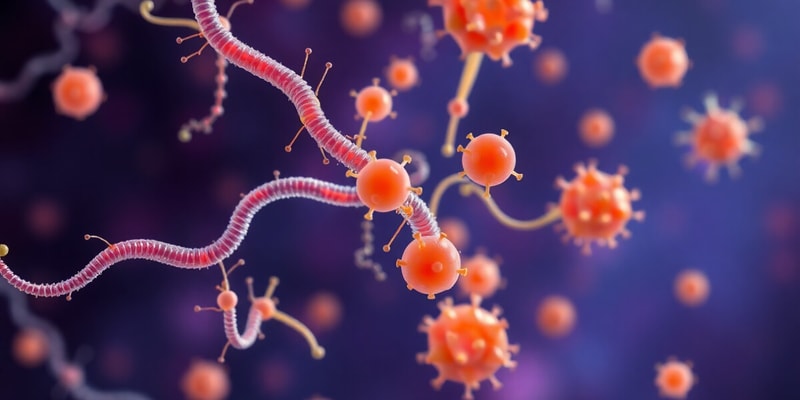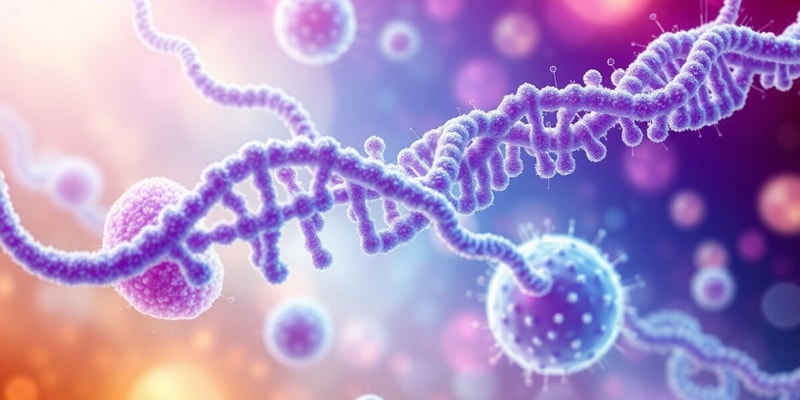Podcast
Questions and Answers
Which amino acids are most commonly involved in forming hydrogen bonds with DNA bases?
Which amino acids are most commonly involved in forming hydrogen bonds with DNA bases?
What is the primary characteristic of a domain within DNA-binding proteins?
What is the primary characteristic of a domain within DNA-binding proteins?
Which of the following motifs is characterized by two alpha helices connected by a turn?
Which of the following motifs is characterized by two alpha helices connected by a turn?
What effect do DNA-binding proteins have when they attach to DNA?
What effect do DNA-binding proteins have when they attach to DNA?
Signup and view all the answers
What is a significant feature of the dynamic nature of DNA-binding proteins?
What is a significant feature of the dynamic nature of DNA-binding proteins?
Signup and view all the answers
What is a critical aspect of gene regulation for prokaryotes like Escherichia coli?
What is a critical aspect of gene regulation for prokaryotes like Escherichia coli?
Signup and view all the answers
What is the primary function of regulatory genes in gene expression?
What is the primary function of regulatory genes in gene expression?
Signup and view all the answers
How do multicellular organisms achieve specialization among different cell types?
How do multicellular organisms achieve specialization among different cell types?
Signup and view all the answers
Constitutive genes are characterized by which of the following?
Constitutive genes are characterized by which of the following?
Signup and view all the answers
Which regulatory mechanism is more significant in bacteria compared to eukaryotes?
Which regulatory mechanism is more significant in bacteria compared to eukaryotes?
Signup and view all the answers
What is the main advantage of gene regulation in prokaryotes?
What is the main advantage of gene regulation in prokaryotes?
Signup and view all the answers
What determines the stability of mRNA in both bacterial and eukaryotic cells?
What determines the stability of mRNA in both bacterial and eukaryotic cells?
Signup and view all the answers
Why is gene regulation important for all living organisms?
Why is gene regulation important for all living organisms?
Signup and view all the answers
At which level of gene regulation does the alteration of DNA or chromatin structure primarily occur?
At which level of gene regulation does the alteration of DNA or chromatin structure primarily occur?
Signup and view all the answers
What type of genes do structural genes encode?
What type of genes do structural genes encode?
Signup and view all the answers
Which statement best describes positive control in gene regulation?
Which statement best describes positive control in gene regulation?
Signup and view all the answers
What is one major difference between prokaryotic and eukaryotic gene regulation?
What is one major difference between prokaryotic and eukaryotic gene regulation?
Signup and view all the answers
Which of the following factors does NOT affect the rate of translation in protein synthesis?
Which of the following factors does NOT affect the rate of translation in protein synthesis?
Signup and view all the answers
Which type of RNA is not directly encoded by genes that include coding sequences for proteins?
Which type of RNA is not directly encoded by genes that include coding sequences for proteins?
Signup and view all the answers
What is the significance of having a subset of genes expressed in individual cells of a multicellular organism?
What is the significance of having a subset of genes expressed in individual cells of a multicellular organism?
Signup and view all the answers
Which of these processes is associated with posttranslational modification?
Which of these processes is associated with posttranslational modification?
Signup and view all the answers
Study Notes
Gene Regulation: Importance and Mechanisms
- Gene regulation is crucial for both unicellular adaptability and multicellular specialization.
- Prokaryotes like Escherichia coli respond to environmental changes by altering their biochemistry.
- These bacteria only express the subset of genetic information needed for the current environment, saving energy.
- Multicellular eukaryotes, such as nerve and kidney cells, utilize gene regulation to express specific proteins essential for their unique functions.
- This specialization is achieved by selectively expressing genes in different cell types.
Gene Regulation in Prokaryotes
- E. coli can't alter their external environment.
- They maintain flexibility by adapting their internal biochemistry.
- When glucose is available, it is used for ATP production.
- If glucose is absent, the bacteria use other sugars like lactose, arabinose, maltose, etc.
- Producing all possible enzymes for each circumstance is energetically expensive.
- Only a subset of genes is expressed to optimize resource usage.
Gene Regulation in Eukaryotes
- Multicellular organisms have specialized cells with different protein expression.
- Gene expression is controlled to match the specific function of the cell.
Definitions
- Gene: A DNA sequence transcribed into an RNA molecule.
- Structural genes: Genes encoding proteins used in metabolism, biosynthesis, or structural roles.
- Regulatory genes: Genes whose products (RNA or proteins) interact with other DNA sequences, impacting transcription or translation.
- DNA-binding proteins: Proteins that bind to DNA sequences and regulate gene expression.
- Constitutive genes: Genes expressed continually, usually for essential cellular functions.
- Regulatory elements: DNA sequences that aren't transcribed but affect gene expression for target DNA sequences.
Prokaryotic vs. Eukaryotic Gene Regulation
- Bacterial and eukaryotic gene regulation share similar aspects.
- Bacterial regulation shows differences in mechanism compared to eukaryotes.
Levels of Gene Regulation
- Gene expression can be controlled at various levels:
- DNA structure alteration
- Transcription
- mRNA processing
- mRNA stability
- Translation
- Post-translational modification
DNA-Binding Proteins
- Crucial for gene regulation.
- Bind to specific DNA sequences to control gene expression.
- Proteins have discrete functional domains for DNA binding.
- Amino acid interactions in domains determine DNA binding specificity.
DNA-Binding Protein Motifs
- Proteins typically have specific motifs for DNA-binding like:
- Helix-turn-helix
- Zinc finger
- Leucine zipper
- Homeodomain
- Steroid receptor
Studying That Suits You
Use AI to generate personalized quizzes and flashcards to suit your learning preferences.
Related Documents
Description
Explore the significance of gene regulation in both prokaryotes and multicellular eukaryotes. Understand how organisms adapt to environmental changes by selectively expressing genes and optimizing their internal biochemical processes. This quiz covers the mechanisms that allow cells to specialize and function effectively.




